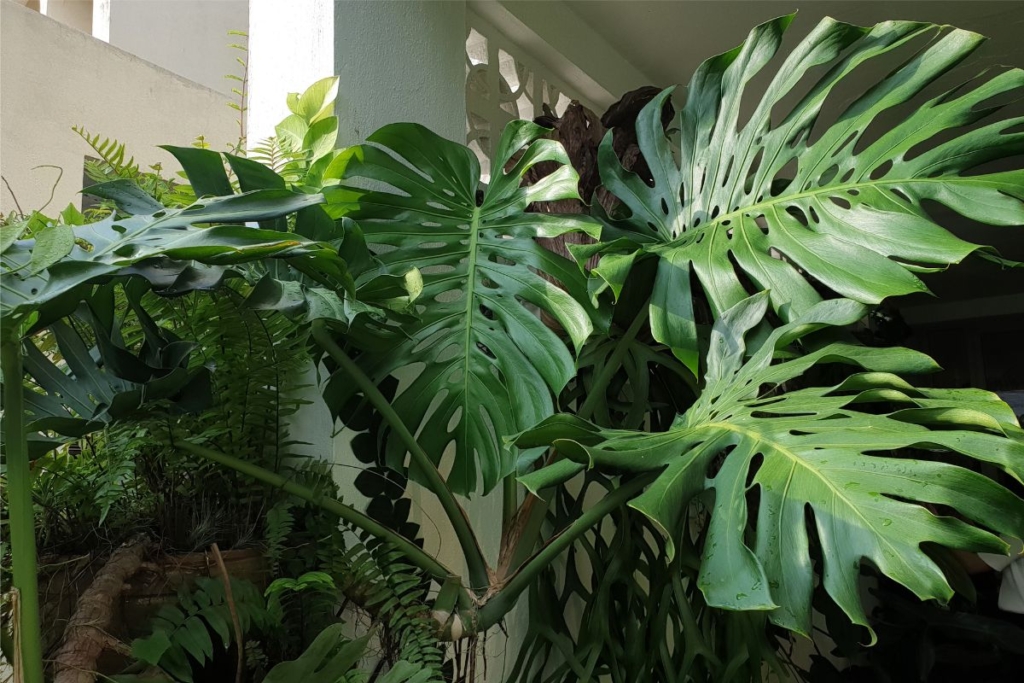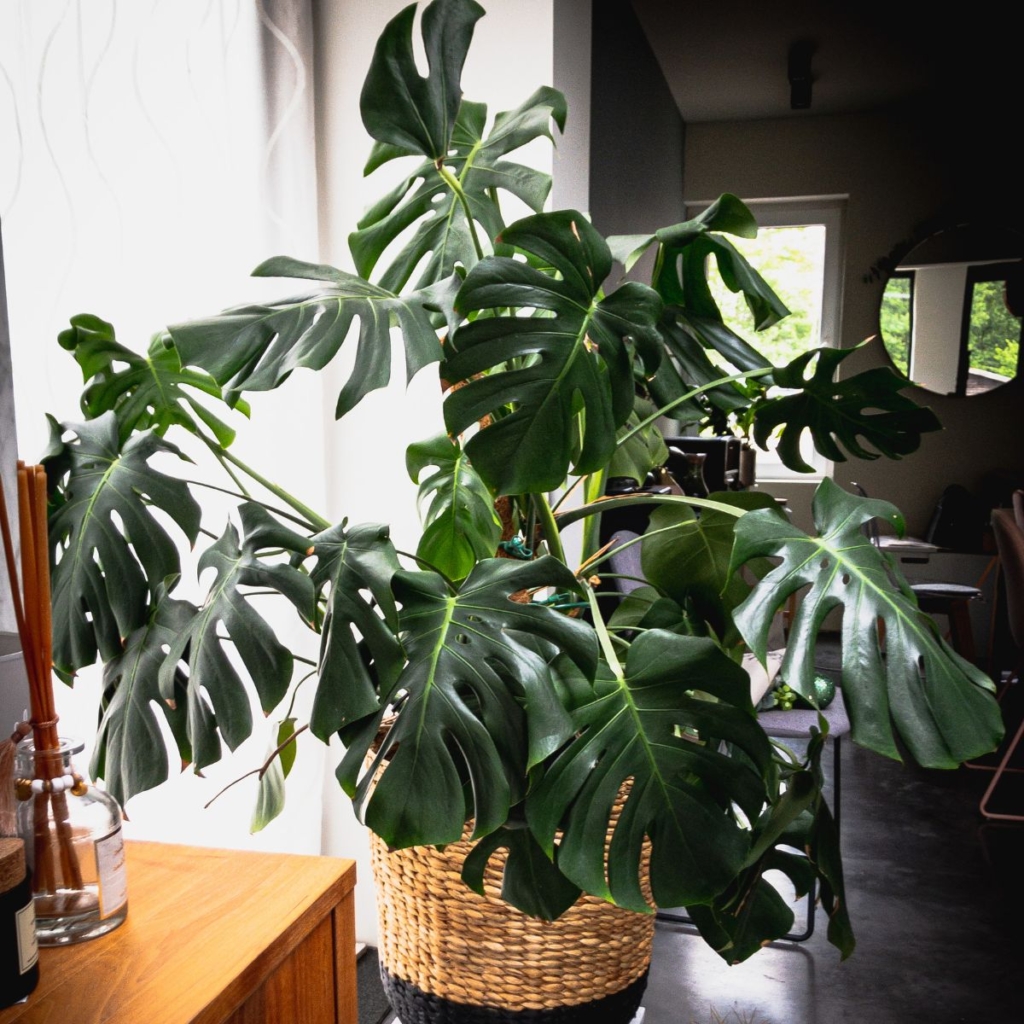Hey there plant fam! Are you a Monstera lover looking to grow some big, beautiful leaves that will have all your friends green with envy? Look no further, because today I’m going to share with you my tried and tested tips on how to grow big monstera leaves like a pro.
Monsteras are known for their iconic, fenestrated leaves that bring a touch of the jungle to any room. But getting those picture-perfect leaves takes some effort and knowledge. That’s why I’m excited to share with you my personal tips on how to grow huge monstera leaves that will make your plant the talk of the town. So, grab your gardening gloves and let’s get started!

Contents
- 1 How Big Do Monstera Leaves Grow?
- 2 At What Age Do Monstera Plants Produce Huge Leaves?
- 3 6 Reasons Why Your Monstera Leaves Are Small
- 4 7 Tips On How To Grow Big Monstera Leaves
- 5 Frequently Asked Questions
- 5.1 Why is my Monstera not producing big leaves?
- 5.2 What is the best fertilizer for Monstera?
- 5.3 Why are my Monstera leaves so small?
- 5.4 Do leaves get bigger with less light?
- 5.5 How do you encourage root growth in Monstera?
- 5.6 Why is my Monstera not growing aerial roots?
- 5.7 Where can I cut Monstera to encourage growth?
How Big Do Monstera Leaves Grow?
One of the most exciting things about growing monsteras is watching those leaves get bigger and bigger over time. But just how big can they get? Well, it all depends on the species and growing conditions.
Monstera deliciosa, also known as the Swiss cheese plant, is perhaps the most popular variety of monstera and can produce leaves up to three feet long and two feet wide! That’s right, these plants can grow some seriously impressive leaves. Other species of monstera, such as Monstera obliqua, have much smaller leaves, but are still highly coveted by plant collectors due to their unique appearance.
So, if you’re dreaming of big, beautiful monstera leaves, don’t be afraid to give your plant the space and resources it needs to grow. With a little bit of patience and care, your monstera might just surprise you with some impressive foliage.

At What Age Do Monstera Plants Produce Huge Leaves?
Another question that many monstera growers have is at what age their plant will start producing those huge, holey leaves. Again, this can vary depending on the species and growing conditions.
In general, monsteras will start producing larger leaves as they mature and grow taller. It’s not uncommon for young monsteras to produce small, juvenile leaves at first, which may not have the same fenestrations as their larger counterparts. As the plant grows, it will start producing larger and more mature leaves that have the iconic holes and splits that we all know and love.
Some growers have reported that providing their Monstera deliciosa with a moss pole or other support can encourage the plant to produce larger leaves at a younger age. Additionally, ensuring that your monstera is getting enough light, water, and nutrients can also help it to grow healthy and strong leaves more quickly.

So, if you’re looking to grow some giant monstera plants, remember to be patient and provide your plant with the care and resources it needs to thrive. With a little bit of time and effort, you’ll be rewarded with some seriously impressive foliage that will make your plant the envy of all your friends.
6 Reasons Why Your Monstera Leaves Are Small
As a seasoned houseplant enthusiast, I know firsthand the frustration of seeing your monstera produce small or stunted leaves. But fear not, because there are several reasons why this might be happening, and solutions to help your plant get back on track.

1. Lack of light
Monsteras need bright, indirect light to thrive and produce large leaves. If your plant isn’t getting enough light, it may produce smaller leaves as a result. Try moving your plant to a brighter spot (but keep away from direct sunlight), or supplementing its light with artificial grow lights.
2. Underwatering
Monsteras like to be kept consistently moist, but not waterlogged (which can cause root rot). If you’re not watering your plant enough, its leaves may become small and yellowed. Make sure to water your monstera when the top inch of soil is dry, and ensure that it’s draining properly.
3. Overfertilization
While fertilizing your monstera can help it to grow, too much fertilizer can actually have the opposite effect and lead to smaller leaves. Make sure to follow the recommended guidelines for fertilizing your plant, and avoid overdoing it.
4. Lack of nutrients
In addition to fertilizer, monsteras need a range of nutrients to grow large, healthy leaves. If your soil is depleted or lacking in essential nutrients, your plant may produce smaller leaves. Consider supplementing your soil with organic matter, or using specialized plant food.
5. Pests or disease
Pests and diseases can also cause your monstera to produce small or stunted leaves. Keep an eye out for common pests like spider mites and mealybugs, and treat them promptly if you spot any signs of infestation. Additionally, ensure that your plant is not suffering from any diseases, such as root rot.
6. Genetics
Finally, it’s worth noting that genetics can also play a role in the size and shape of your monstera leaves. Some monsteras may simply be genetically predisposed to produce smaller leaves, regardless of growing conditions.
In conclusion, if you’re struggling with small monstera leaves, it’s important to assess your plant’s growing conditions and address any issues that might be hindering its growth. With a little bit of care and attention, your monstera will be back to producing those big, beautiful leaves in no time.
7 Tips On How To Grow Big Monstera Leaves

Over the years, I’ve learned a thing or two about how to grow big, beautiful Monstera deliciosa leaves. Here are seven tips to help your plant produce the impressive foliage that you’ve been dreaming of.
1. Provide bright, indirect light
Monsteras need plenty of bright, indirect sunlight to grow big leaves. Make sure to place your plant in a spot with plenty of natural light, or use artificial grow lights to supplement its light intake.
2. Keep soil consistently moist
Monsteras like to be kept consistently moist, but not waterlogged. Water your plant when the top inch of soil is dry, and make sure that it’s draining properly.
3. Use a well-draining soil mix
Monsteras prefer soil that’s rich in organic matter and drains well. Consider using a high-quality potting mix that’s specifically formulated for tropical plants.
4. Fertilize regularly
Monsteras benefit from regular fertilization, especially during the growing season. Use a balanced fertilizer with equal parts nitrogen, phosphorus, and potassium, and follow the recommended guidelines for your plant’s specific needs.
5. Provide a moss pole or other support
Monsteras are climbers by nature, and providing a moss pole or other support can encourage your plant to grow larger leaves at a younger age.
6. Maintain consistent humidity levels
Monsteras prefer high humidity levels, and benefit from regular misting or the use of a humidifier. Aim for humidity levels of around 60-70% for optimal plant growth.
7. Prune regularly
Finally, pruning your monstera can help it to focus its energy on producing larger leaves. Remove any yellowed or damaged leaves, and consider trimming back any excessively long vines to promote new growth.
By following these tips and giving your monstera the care and attention it needs, you’ll be well on your way to growing giant monstera plants that will make your plant the envy of all your friends. Happy growing!
Frequently Asked Questions
Why is my Monstera not producing big leaves?
There could be a few reasons why your Monstera isn’t producing big leaves. One possible reason is that it’s not getting adequate light. Monsteras require bright, indirect light to thrive and produce large leaves. If your plant is not getting enough light, it may produce smaller leaves or none at all.
Another reason could be that your plant is not getting enough water or nutrients. Monsteras require consistent moisture and regular fertilization to grow to their full potential. Make sure you are watering your plant regularly and feeding it with a balanced fertilizer every few weeks.
Finally, it’s possible that your plant is simply not mature enough yet to produce big leaves. Monsteras can take several years to reach their full size and potential, so patience is key!
What is the best fertilizer for Monstera?
The best fertilizer for Monsteras is a balanced, water-soluble fertilizer with an NPK (nitrogen-phosphorus-potassium) ratio of 20-20-20 or 10-10-10. Look for a fertilizer specifically formulated for indoor plants, and follow the instructions on the package for how often to fertilize and how much to use.
It’s important to note that while fertilizer can be beneficial for Monstera plants, it’s also possible to over-fertilize, which can damage the plant. Be sure to follow the instructions carefully and avoid fertilizing too frequently.
Why are my Monstera leaves so small?
If your Monstera leaves are small, it could be due to a few different factors. One possibility is that your plant is not getting enough light. As mentioned earlier, Monstera plants require bright, indirect light to grow and produce large leaves. Without enough light, the leaves may be smaller than they should be.
Another possibility is that your plant is not getting enough water or nutrients. Monsteras need consistent moisture and regular fertilization to grow and thrive. Make sure you are watering your plant regularly and feeding it with a balanced fertilizer every few weeks.
Finally, it’s possible that your plant is simply not mature enough yet to produce larger leaves. Monsteras can take several years to reach their full size and potential, so it may just be a matter of waiting patiently.
Do leaves get bigger with less light?
No, leaves do not typically get bigger with less light. In fact, if a plant is not getting enough light, it may produce smaller leaves or none at all. Monsteras require bright, indirect light to grow and produce large leaves, so it’s important to make sure your plant is getting enough light.
How do you encourage root growth in Monstera?
To encourage root growth in Monstera plants, you can try repotting the plant into a slightly larger pot with fresh soil. This will give the plant more room to grow and develop new roots. You can also try using a rooting hormone, which can help stimulate root growth.
Another way to encourage root growth is to make sure the plant is getting enough water and nutrients. Monsteras need consistent moisture and regular fertilization to grow and thrive, so be sure to water and feed your plant regularly.
Why is my Monstera not growing aerial roots?
If your Monstera isn’t growing aerial roots, there could be a few reasons for it. One possibility is that it’s simply too young – younger Monstera plants may not have developed the ability to grow aerial roots yet. Another possibility is that the humidity in the plant’s environment is too low. Monsteras thrive in humid conditions, and if the air is too dry, they may not feel the need to grow aerial roots.
Additionally, if your Monstera is already well-established and still not growing aerial roots, it’s possible that it doesn’t need them to support itself. Aerial roots are a way for Monsteras to anchor themselves to trees or other surfaces in their natural environment, but in a pot or other container, they may not be necessary.
If you want to encourage your Monstera to grow aerial roots, try increasing the humidity in its environment by misting it regularly or using a humidifier. You could also try adding a moss pole or other support for the plant to climb, which may encourage it to grow more aerial roots. However, keep in mind that if your Monstera is otherwise healthy and growing well, the absence of aerial roots may not be a cause for concern.
Where can I cut Monstera to encourage growth?
If you want to encourage growth in your Monstera plant, pruning is a great way to do it. You can cut your Monstera in several places to encourage growth.
The first place you can cut is at the base of the stem. This can encourage new growth from the roots and help to rejuvenate an older plant.
Another place you can cut is at the node, which is where a leaf attaches to the stem. This can encourage the growth of a new branch or stem.
Lastly, you can cut back the tips of the plant to encourage bushier growth. This will stimulate the growth of new leaves and branches and help to keep the plant looking full and healthy.
